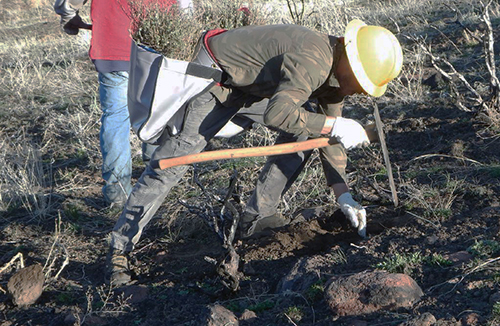Re-Planting After a Fire: Sagebrush Restoration
By: Emily Nason
Posted on:03/06/2018 Updated:03/30/2018After any kind of wildfire, big or small, it is imperative that the trees and plants are replanted within a reasonable time after a fire, insect infestation, disease or weather takes its toll.

After any kind of wildfire, big or small, it is imperative that the trees and plants are replanted within a reasonable time after a fire, insect infestation, disease or weather takes its toll. If there is too much delay, invasive species of trees and brush that are fire-prone could take over, wildlife will not have critical habitat and critical watershed areas will no longer be able to provide clean water.
Restoring native sagebrush-steppe plants after wildfires has become an important issues because of the focus on recovering sage grouse populations in Idaho and the West. Sagebrush provides a vital cover for nesting habitat and the overall health of the bird. According to a recent article in Conservation the Idaho Way, a publication of the Idaho Soil and Water Conservation Commission, In looking into other examples of sagebrush-restoration projects that have occurred after large fires in Southwest Idaho, such as the Soda wildfire in 2015, the Pony and Elk complex fires in 2014, and the restoration efforts in the Morley Nelson Snake River Birds of Prey National Conservation Area, agency officials have had mixed results.
Researchers are looking into why it’s difficult to establish sagebrush in its native range, but at the same time, they recommend using best practices and to carefully monitor the results. Local ranchers also have experience with restoring sagebrush and they believe that combining livestock grazing into the mix can help with restoration efforts.
It has become common practice for public agencies to use hand-planting treatments and aerial seeding of sagebrush following large-scale fires, and drill-seeding of perennial grasses and forbs. The hope is that restoring native plant communities will give nature a jump-start in recovery.
Cindy Fritz, a restoration expert for the Bureau of Land Management (BLM), was in charge of the rehabilitation efforts on the Pony complex fire zone in the fall and winter following the wildfire. The BLM aerially seeded 32,800 acres of land with native grasses, alfalfa and sagebrush.
“See this sagebrush plant coming up? This is from our aerial seeding,” she said. “That’s what we want to come back. This is for sage grouse. On a favorable year, aerial seeding is a good way to get sagebrush in the ground.”
While most people in the scientific community recommends resting the land after wildfires for about two years to allow new plants to germinate and take root, ranchers believe that livestock grazing can help speed up this process. Sagebrush responds well to soil disturbance, says Jeff Lord, a Mayfield rancher. After the Soda and Elk complex fires burned nearly 280,000 acres of BLM and U.S. Forest Service land, rancher Charlie Lyons didn’t have many places to take his cattle. He sold off part of his cattle herd, and he grazed on his own pastures while the Forest Service lands nest to his pastures were rested.
While the agencies spent funds on drill-seeding and aerial seedings to give Mother Nature a jump start on recovery, Lyons said he didn’t think it was necessary to plant sagebrush on his land. Just by grazing cattle on 180 acres of land at 4,500-foot elevation, he had sagebrush shoots coming up everywhere his cows grazed.
“The seed source was already there in the soil,” Lyons said. “The cattle eliminate the competition with the grass, and the sagebrush comes exploding back with a vengeance.”
While ranchers have experienced some success, it remains baffling as to why sagebrush restoration has been difficult elsewhere in the sagebrush-steppe habitat, particularly in low-elevation. Lack of precipitation and drought following seedings on rangelands seem to be a major factor that makes it difficult for plants to survive. Continued research and monitoring are needed to provide more answers down the road.
Read the Full article in Conservation the Idaho Way
 Sign In
Sign In
 Sign In
Sign In
